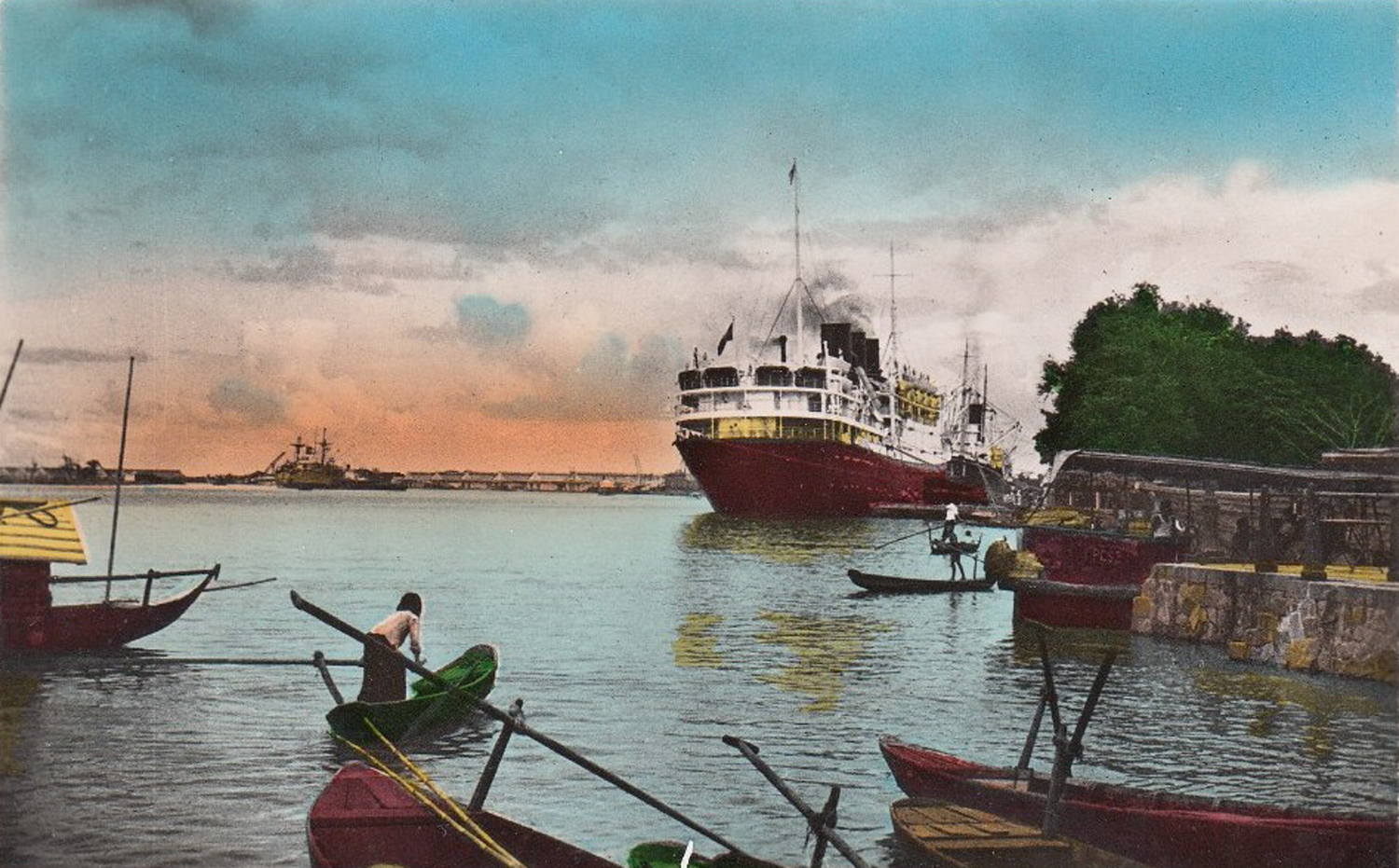
Saigon port in the 1920s
Though arrogant and condescending in its tone, A Desbordes’ 1919 assessment of what’s wrong with tourism in Saigon – published in his journal Les Affiches saïgonnaises on 10 October 1919 – nonetheless sheds light on the appalling conditions suffered by many poor people in the “Pearl of the Orient”
How many cruise ships of the large foreign shipping lines ever stop in Saigon? Not one! Shouldn’t there be some way to reroute them, so that they bring us their tourists? In theory, yes. But given the current state of our port, no!
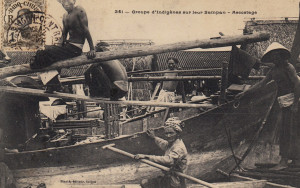
Sampan boatmen in Saigon
We must develop our port, dredging the river and building new docks, so that these giants of the seas can moor. Better still, we should to reduce the horrifying five hour journey up river from Cap-Saint-Jacques by digging a direct canal from the Cap to Saigon, in order to facilitate the journeys of these ships. After all, they not only bring travellers, but also come to load up with our products. We must give proper consideration to commercial needs and create what does not currently exist – modern equipment for loading and unloading ships, and above all, the facilities of a large, modern commercial port.
We have already addressed this matter in previous issues, and we promised to return to it. However, we’ll stop there and say no more about it. Instead, let’s ask ourselves, do we really want to carry out all these works?
When our tourist wants to venture beyond Saigon and go on an excursion, will he be able to find the level of physical comfort he can enjoy on board the steamships of the Messageries maritimes and in our Saigon hotels? Again, we must say, no, a thousand times, no. Far from it.
So, away from our beautiful roads which lead nowhere, let’s review the means of transport at our disposal. Comfort, we must admit, is rather absent.
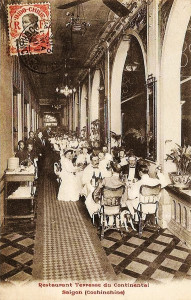
The interior of the Continental Hotel, early 20th century
Outside Phnom Penh, in what other centre of Cochinchina, Annam and Cambodia visited by the tourist can he hope to find the comfort he needs? In Angkor, and also in Dalat, such comfort is unknown; even more so in Tourcham [Tháp Chàm], a place where our tourist may be forced to spend a night or day. There, he will have to stay in a one-room apartment without water or shower, make use of a dubious laundry service and suffer the vulgar cuisine of a spoil-the broth Chinese cook. The train which will convey him from Saigon to Langbian [Đà Lạt] doesn’t even offer him facilities to quench his thirst or sate his hunger. Can we call that comfort?
But let’s return to Saigon, for it could be that the tourist has decided not to go any further, not to stay here any longer, but to leave quickly.
Let’s consider what awaits our great tourist when his ship arrives.
If he arrives on a Messageries vessel, it moors in the quay of the Messageries, but if he arrives on a foreign vessel, it is moored in the open river against a buoy and he is transferred to land by sampan (first trouble).
We meet him and join him on his journey to the hotel, which he has chosen at random. At our exit of the “seigneurial domain” of the Messageries maritimes, we find the path leading to the swing bridge crowded with vehicles of all kinds, so instead, we continue straight on.
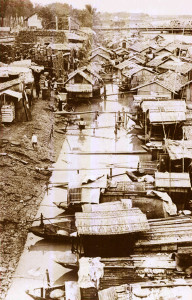
Housing alongside the arroyo-Chinois
On his left, the tourist – who after all came here to take in the sights – sees a few remnants of the earliest European homes, of the kind one often encounters in and around the equatorial ports, adding a bit of local colour. There is a house and an attractive restaurant on stilts; but our tourist’s attention is immediately drawn by the wild shouts and savage screams of a group of children on his right, more or less dressed, but each dirtier than the other. His olfactory nerve having detected a disagreeable aroma, he spies in the damp mud in front of the row of “compartments” (a word consecrated by the owners to designate buildings slightly taller but little more comfortable than a cowshed) a ditch full of sewage.
The ditch is loosely covered with boards, and into the gaps between them, local residents throw everything they can no longer keep in their homes. Part of what lies underneath is visible through the gaps, and further scrutiny reveals that there are children under there, buried up to their waists in the filthy mud. As they stir it, the mud emits sufficient stench to generate an outbreak of plague. They are fishing with both hands for crabs and small fish, which are either eaten, taken to the market, or sold to restaurants, some of which occupy riverside dwellings alongside fruit merchants, tailors and hairdressers.
Our tourist suppresses the urge to retch and leads us on quickly, not without noticing that each of the houses contains an average of 15 to 20 people, a number which at night is doubled if not tripled, in an area of just 20 square metres and a height of just 3 metres!
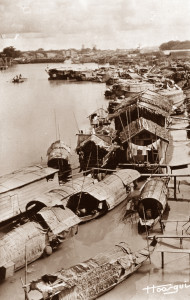
More housing alongside the arroyo-Chinois
A little further along the left, the spectacle is more or less the same, except that the buildings are made of wood and have at their rear a large cesspit, into which all kinds of rotting carcasses –dogs, cats, pigs, etc – are constantly thrown.
Our first contact with the “Pearl of the Orient” is, as we confess with shame, rather painful, and our tourist, who remembers having heard that cholera and plague are latent in Saigon, begins to be convinced.
Arriving on the bridge [pont des Messageries maritimes], our view of the banks of the arroyo (the name applies well) suggests to us that their maintenance does not much encumber the budget. The ramp which we follow to descend the bridge presents the curiosity of two tiny sidewalks, unusable for pedestrians from one end of the year to the other, since they are always crowded with heaps of garbage – that is, when the latter, in all its forms, is not scattered everywhere, which is far from being an attractive sight.
To avoid this spectacle, we take instead the staircase which descends from the other side of the bridge to the quai de Belgique [Võ Văn Kiệt]. Here we find our steps less congested, but unfortunately, the smell of ammonia is such that even a blind man could identify this as the quarter’s public urinal.
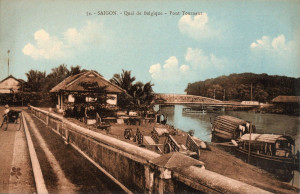
The swing bridge, viewed from the ramp of the pont des Messageries maritimes
We stop for a moment at a bank on the corner of rue d’Adran [Hồ Tùng Mậu], and then we immediately head out onto that street again, to avoid the dust on the quayside produced by vehicles travelling from the ship.
However, since the pavement on our right hand side is crowded, we are obliged to walk in the street, where mud reigns from one end of the year to the next, even in the driest period.
Hardly have we resumed our journey than another awful, unbearable smell seizes our nostrils. Our friends the Chinese merchants, selling dried or rotting fish, force us to run away as fast as possible. These gentlemen of special refinement have chosen our banking and consulates district as the location for their warehouses and shophouses!
By now, our companion – a tourist, let’s not forget – can bear it no more and asks to be taken away from all of these noxious and unhealthy odours. We rejoin the quayside as quickly as possible, heading for the rue Catinat [Đồng Khởi], the name of which is not unknown to him.
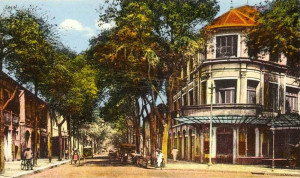
A view looking up the rue Catinat
Wanting to see everything, our companion choses the left pavement, onto which we step slowly. As we walk, we pass countless money changers, tailors and shoemakers, which follow each other almost without interruption.
I have nothing to say about this – except firstly that there are far too many of them and they would be better accommodated in the smaller adjacent streets. They certainly do not embellish our main city artery in which, every day, the European element is seen to be increasingly repressed.
Secondly, the foreigner does not hide his surprise to observe in this street some rather dirty groups of children playing on the sidewalk, and also to breathe the puffs of air wafting from the back rooms of these shops. The latter is nothing to celebrate, because it reminds us uncannily of the smell that emanates from a pigsty. That is not surprising, because everyone knows that the Chinese like to raise ducklings and piglets in their own back yards.
A stop near the Theatre and a short visit to his apartment appears to satisfy our tourist, but despite his politeness, he can’t conceal from us the fact that his stay in Saigon hasn’t made him smile a great deal and he has the urge to get back on the boat.
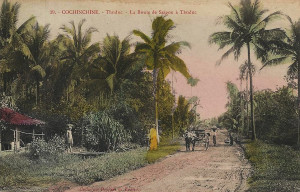
The road to Thủ Đức
Yet, the hot hours having ended, and wishing to see more of Saigon, we decide to take a trip by car. This hunting promenade seems to compensate for the bad impression given to him on our arrival, but the next morning, everything seems to have been compromised again.
Our tourist does indeed want to go back on board ship. We ask to accompany him. We hire a pousse-pousse, and this time we take the swing bridge. Alas for this crossing! The view of the ditch which borders the street leading to the Messageries, and the awful smell emanating from the stagnating mud which workers are at that moment attempting to move, blocking the pathway reserved for pedestrians, once more evokes a negative reaction. Again, we fear that our visitor will decide to leave us at the earliest opportunity.
We will not dwell longer on these curiosities of our “Pearl,” but can we really believe that such a state of things, with such a lack of moral comfort and the constant apprehension of an epidemic, is any way to recommend a city which is so nice and welcoming in other ways. It’s not for us here to identify those responsible for all this, nor to suggest ways to address it, but a local government worthy of the name should aim to rectify the problems as quickly as possible.
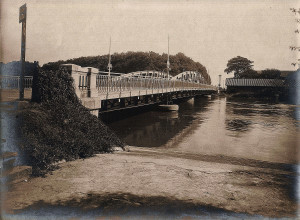
The swing bridge in the 1920s by Leon Ropion
Let’s just say that, as long as all these drawbacks remain, Saigon will never be thought of as a favourite stopover for tourism or grand touring. How much effort, how many initiatives will be needed by the tourist office and the official tourism bureau in order to change all of this, and how many years will it take to get there, taking into account all of the various vested interests.
Of all necessity, however, these pestilential nests must be destroyed and sanitised, because like it or not, such warts never constitute an attractive sight. Despite the authorities’ lack of concern about public health, and despite of all the difficulties as well as the indifference of some, are we prepared to act?
We ask this question, and if we are afraid to encroach on the political field, we should say that this must be the first programme of any candidate in the upcoming elections. The voters can speak and say what they want: a clean and comfortable city, a modern port or an Asian city!
A Desbordes
Tim Doling is the author of the guidebook Exploring Saigon-Chợ Lớn – Vanishing heritage of Hồ Chí Minh City (Nhà Xuất Bản Thế Giới, Hà Nội, 2019)
A full index of all Tim’s blog articles since November 2013 is now available here.
Join the Facebook group pages Saigon-Chợ Lớn Then & Now to see historic photographs juxtaposed with new ones taken in the same locations, and Đài Quan sát Di sản Sài Gòn – Saigon Heritage Observatory for up-to-date information on conservation issues in Saigon and Chợ Lớn.

